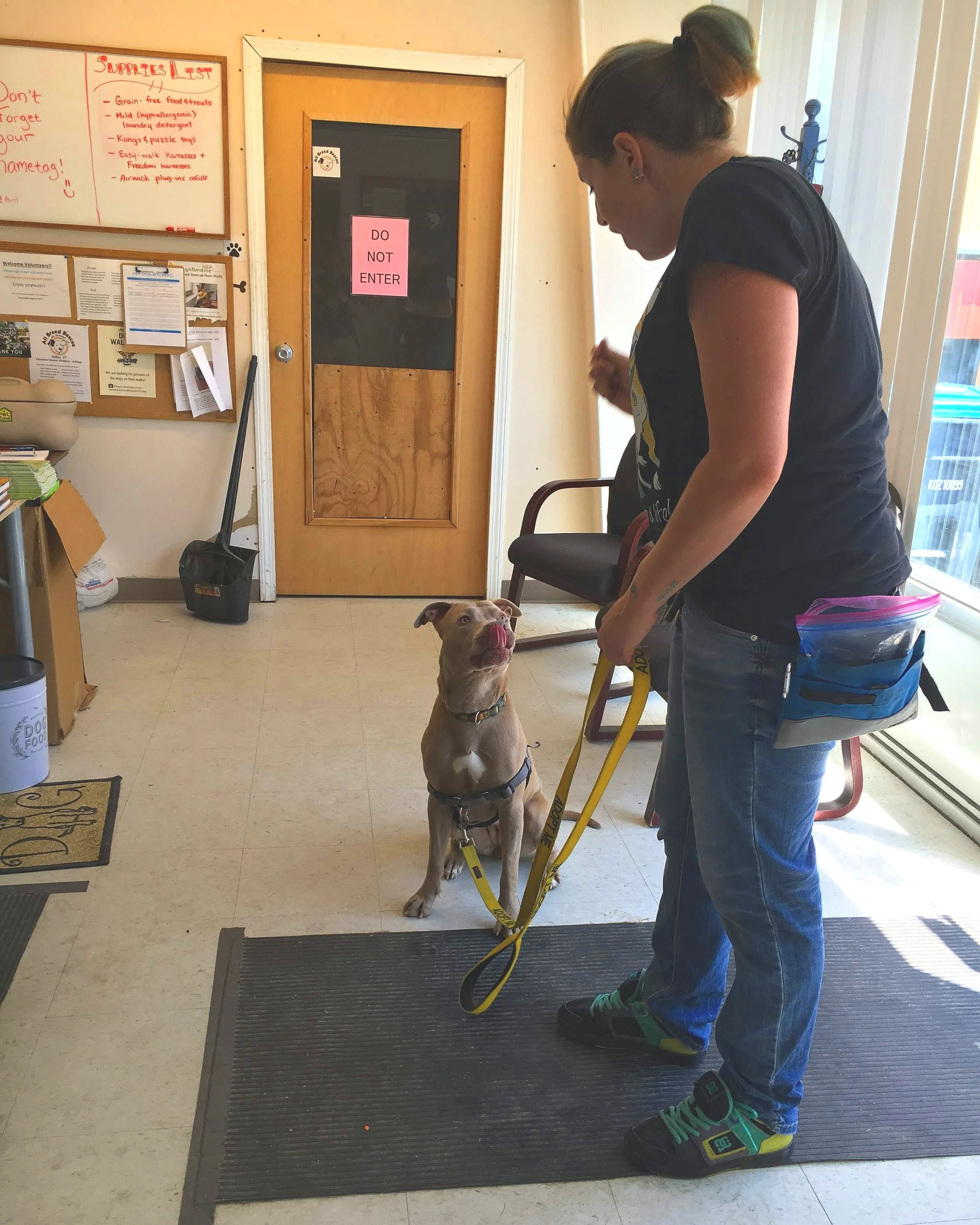Animal Shelter Best Practices: Why We Don’t Use Punishment
When it comes to animal shelter best practices, one thing is certain: punishment should never be used on rescue dogs. Many old-school dog trainers still believe that dogs cannot be properly trained without aversive measures, but modern research has come to show that positive reinforcement training is the better option.
In fact, in a study by the Animal Behavior, Cognition, and Welfare Research group at the University of Lincoln, researchers found that reward-based training was the most effective approach compared to more aversive methods. On top of being less effective, punishment can have harmful effects on dogs’ behavioral and physical help. Let’s talk about why we don’t use punishment and why you shouldn’t either.
How Punishment Works
Punishment is any aversive intervention – like physical corrections, intimidation, and prong collars – that aims to decrease a problem behavior. And sure, punishment can stop problem behaviors… if it’s administered within a very narrow set of circumstances. For punishment to be effective, you’ll have to meet these 3 sets of criteria:
The aversive intervention must be introduced immediately after a problem behavior occurs. If you don’t catch the behavior within two seconds, it’s likely that the dog won’t associate the punishment with the behavior you’re trying to stop.
The aversive intervention must occur every. single. time. that a problem behavior occurs.
The intervention needs to be aversive enough to discourage the unwanted behavior… but not so aversive that it causes fear.
The Alternative: Positive Reinforcement
Do you think it’s possible to consistently meet the three conditions listed above? I think it’d be pretty tough. But what should you do instead?
Laurie Lawless, animal behavior expert and founder of Lawless Shelter Behavior, recommends that shelter employees use positive reinforcement methods instead of punishment. If punishment teaches dogs what they shouldn’t do, positive reinforcement teaches them what they should do by using positive stimuli, like treats or praise, to reward a dog when they perform a desirable behavior. This is less stressful for the animal, and there is less potential for behavioral fall out now or down the road.
Animal Shelter Best Practices: Why We Don’t Use Punishment
Punishment should never be used in a shelter environment. Because punishment has to occur within a very narrow set of circumstances to even be effective, it’s extremely difficult to get the results you’re looking for in the best of circumstances. In a chaotic shelter environment, it’s virtually impossible. When administered improperly, punishment can cause new problems, exacerbate old ones, and cause negative health outcomes.
Punishment is Confusing
Punishment has the potential to cause a lot of confusion in your shelter environment. Here’s what Laurie has to say about how this shows up in her work:
“When we’re using punishment, the goal is to decrease a behavior. But, without teaching the animal the actual response that you would like instead, we actually end up suppressing behaviors only in very special circumstances or certain environments, and we’ll end up seeing a resurgence of that behavior later.”
In fact, if not administered within the two-second window, dogs may not even associate punishments with the behaviors we are trying to decrease. Instead, they might associate the negative stimulus with another event that has nothing to do with the behavior you’re trying to stop.
Punishment is simply not an instructive form of training, and this confusion can lead to problems that persist even after adoption. Laurie notes that punishment might cause the suppression of a problem behavior in the shelter environment or with a specific handle, but “when that animal gets into a home, those behaviors may resurface again because the context has changed and we never really replaced the behavior with an alternative.”
2. Punishment Damages Your Relationship
One of the unintended consequences of punishment is that it can teach dogs that humans are dangerous. In a study of German Shepherds trained with electronic shock collars, the results found that they showed more signs of fear toward their handlers than dogs who were trained with less aversive methods. This is especially damaging to shelter dogs, who need to build relationships with humans in order to get adopted and thrive in a new home.
3. Punishment Causes Other Behavioral Issues
Punishment is meant to decrease problem behaviors, but it can often cause the reverse. Many problem behaviors are the result of fear and anxiety, and punishment does nothing but worsen these feelings, thereby increasing the original behaviors and potentially creating new ones.
In fact, various studies have found that aversive training methods lead to unwanted behaviors, like aggression. In a questionnaire survey of dog owners, the respondents’ answers revealed that there’s an association between punishment-based training techniques and undesirable behaviors. Similarly, in a study investigating the relationship between owners’ training methods and the behaviors of small and large dogs, researchers found that aversive training techniques caused dogs to have increased levels of aggressive behaviors.
4. Punishment Leads to Stress and Health Issues
Did you know that cortisol, the stress hormone, stays in a dog’s bloodstream for up to 72 hours? In a study aimed at evaluating the effects of different training methods, researchers found that dogs who experienced aversive training methods were more stressed, had higher cortisol levels, and displayed more stress-related behaviors like panting and tense body language.
The effects of stress are long-lasting, affecting both behavioral and physical health. Excess cortisol levels can even leave dogs vulnerable to illnesses, like kidney disease and diabetes.
5. Punishment is Cruel
Laurie put it best when she said: “Shelters are full of enough environmental punishers for dogs already, so purposefully adding further punishing aspects to a dog’s life is unethical cruel, and not in anyone’s best interest in the long term.”
In the face of all of this evidence, it’s clear that punishment is an outdated and unnecessary training method. Shelter workers have a responsibility to keep up with the research and learn better ways to address the behavioral struggles of the dogs in their care.
Keeping Up with Animal Shelter Best Practices
In the day-to-day chaos of the shelter, it can sometimes be hard to look at the bigger picture. Burnout, stress, or lack of knowledge can often cause shelter workers to lose sight of animal shelter best practices. That’s why Laurie Lawless has made it her mission to help shelter workers to keep up with best practices so that they can do right by the animals in their care. Check out the Laurie Lawless Shelter Behavior website to learn more about Laurie, utilize our educational resources, and access her consulting services.



